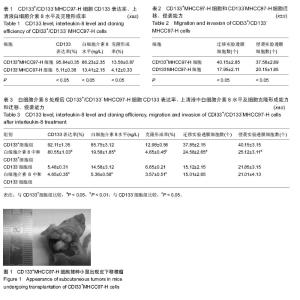| [1] 张翔,林承杰,黄新辉,等.白细胞介素-8对CD133+肝癌干细胞侵袭转移能力的影响[J].中华实验外科杂志,2014, 31(8):1706-1708.
[2] 侯妍利,唐敏,陈兴月,等.分离、鉴定CD133+人肝癌干细胞以及131I-CD133mAb对其生物学效应的影响[J].第三军医大学学报,2014,36(3):222-227.
[3] 周蓓,肖立红,肖荞,等.8-溴-7-甲氧基白杨素对Huh-7细胞系肝癌干细胞样细胞自我更新的影响[J].湖南师范大学学报:医学版,2013,10(1):10-14.
[4] 贾茜,高建,张小丽,等.HepG2、Hep3B细胞中肿瘤干细胞相关标志分子的表达[J].第三军医大学学报,2012,34(9): 852-856.
[5] 张俊松,汪宏,吴立胜,等.CD105、CD133在人肝癌细胞株HepG-2的表达情况及生物学性状的体外研究[J].肝胆外科杂志,2013,21(2):133-136.
[6] 侯妍利,陈兴月,段丽群,等.131I标记CD133单链抗体对人肝癌CD133+HepG2干细胞的抑制作用[J].中国肿瘤生物治疗杂志,2014,21(1):7-13.
[7] 宋玉姣.自噬在CD133+肝癌干细胞耐受缺氧缺营养肿瘤微环境中的作用及机制研究[D].上海:第二军医大学, 2013.
[8] Bostad M, Berg K, Høgset A, et al. Photochemical internalization (PCI) of immunotoxins targeting CD133 is specific and highly potent at femtomolar levels in cells with cancer stem cell properties. J Control Release. 2013;168(3):317-326.
[9] Miyabayashi T, Kagamu H, Koshio J, et al. Vaccination with CD133(+) melanoma induces specific Th17 and Th1 cell-mediated antitumor reactivity against parental tumor. Cancer Immunol Immunother. 2011;60(11): 1597-1608.
[10] 徐衍,沈永杰,安玉会,等.大豆黄酮对人肝癌SMMC7721细胞己糖激酶活性和癌干细胞CD133蛋白水平的影响[J].河南职工医学院学报,2013,25(3):240-244.
[11] Zucchi I, Astigiano S, Bertalot G, et al. Distinct populations of tumor-initiating cells derived from a tumor generated by rat mammary cancer stem cells. Proc Natl Acad Sci U S A. 2008;105(44):16940-16945.
[12] 黄涛,宫东伟,高全立,等.肝癌SMMC-7721细胞中侧群细胞干细胞标记的表达[J].中华实验外科杂志,2011,28(1): 65-67.
[13] 肖立红.8-溴-7-甲氧基白杨素对MHCC97-H细胞系肝癌干细胞特性和β-catenin表达的影响[D].长沙:湖南师范大学,2014.
[14] 张荣生,吕凌,张峰,等.CD133作为肝癌干细胞表面标记的初步研究[J].中华消化外科杂志,2009,8(2):116-119.
[15] Qin K, Tian G, Li P, et al. Anti-glioma response of autologous T cells stimulated by autologous dendritic cells electrofused with CD133+ or CD133- glioma cells. J Neuroimmunol. 2012;242(1-2):9-15.
[16] Shmelkov SV, Butler JM, Hooper AT, et al. CD133 expression is not restricted to stem cells, and both CD133+ and CD133- metastatic colon cancer cells initiate tumors. J Clin Invest. 2008;118(6):2111-2120.
[17] 张华,高志红,许田英,等.CD133、CD90在肝癌组织中的表达及其临床意义[J].中国医师进修杂志,2009,32(12): 7-10.
[18] 朱凯,崔迪,韩邦旻.IL-8对膀胱癌T24细胞系干细胞特性维持调控的研究[J].中国现代医学杂志,2014,24(36): 14-18.
[19] 张晓,贾谦,王海婧,等.白细胞介素8及其受体CXCR1对人牙髓干细胞增殖和迁移的影响[J].牙体牙髓牙周病学杂志,2013,23(3):145-148.
[20] 曾慧兰.白细胞介素—8及其受体与白血病关系研究进展[J].国外医学:输血及血液学分册,1997,20(6);337-340.
[21] Vasilyev SA, Kubes M, Markova E, et al. DNA damage response in CD133 + stem/progenitor cells from umbilical cord blood: low level of endogenous foci and high recruitment of 53BP1. Int J Radiat Biol. 2013; 89(4):301-309.
[22] Currie MJ, Beardsley BE, Harris GC, et al. Immunohistochemical analysis of cancer stem cell markers in invasive breast carcinoma and associated ductal carcinoma in situ: relationships with markers of tumor hypoxia and microvascularity. Hum Pathol. 2013;44(3):402-411.
[23] Waugh DJ, Wilson C. The interleukin-8 pathway in cancer. Clin Cancer Res. 2008;14(21):6735-6741.
[24] 闫伟伟,黄昂,王春平,等.肝癌干细胞与肝癌细胞表面分子标记物的鉴别[J].肝脏,2014,19(1):20-23. |

